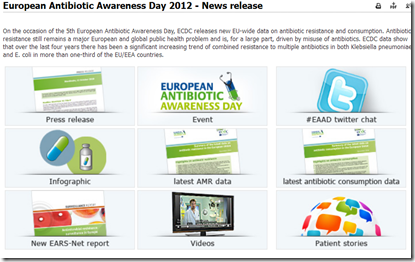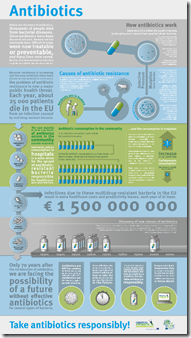Consumption of antibiotics for systemic use in the community in EU/EEA countries, 2010 - Source
# 6721
November 18th is set aside each year by the ECDC and their partners as European Antibiotic Awareness Day. For the past 5 years they have mounted coordinated events to get the message out on the safe and sane use of antibiotics in the face of increasingly resistant bacteria.
You’ll find an excellent infographic, along with a number of other resources, available on the ECDC’s Antibiotics Awareness Day web page.
Coinciding with the 2012 observance, we have the release of new data on the consumption of antibiotics in the EU, along with numbers showing the rise in multi-drug resistant organisms.
A few excerpts from the ECDC news release, followed by links to the reports. Follow the link for more.
Multidrug antibiotic resistance increasing in Europe
16 Nov 2012
On the occasion of the 5th edition of the European Antibiotic Awareness Day, ECDC releases new EU-wide data on antibiotic resistance and consumption. Antibiotic resistance still remains a major European and global public health problem and is, for a large part, driven by misuse of antibiotics. ECDC data show that over the last four years there has been a significant increasing trend of combined resistance to multiple antibiotics in both Klebsiella pneumoniae and E. coli in more than one-third of the EU/EEA countries. In several Member States, between 25 percent and up to more than 60 percent of Klebsiella pneumoniae from bloodstream infections show combined resistance to multiple antibiotics. Options for treatment of patients who are infected with such multidrug-resistant bacteria are limited to only few last-line antibiotics.
Antibiotic resistance is still a very serious threat to the health of European citizens, because it leads to increasing healthcare costs, extra length of stay in the hospital, treatment failures, and sometimes death. Speaking at a press event organised by ECDC and the European Commission in Brussels, ECDC Director Marc Sprenger said: “ECDC data show that over the last several years, there has been a Europe-wide increase of antibiotic resistance and of multidrug resistance in Gram-negative bacteria such as Klebsiella pneumoniae and Escherichia coli (E. coli). This means that, for patients who are infected with these bacteria, few last-line antibiotics, like carbapenems, remain available”.
Furthermore, ECDC data show that consumption of carbapenems – a major last-line class of antibiotics – increased significantly in EU/EEA countries from 2007 to 2010. This is the likely consequence of increasing multidrug resistance in Gram-negative infections, such as bloodstream infections or pneumonia, since carbapenems are often used to treat such infections. However, the percentage of carbapenem-resistant Klebsiella pneumoniae is already high and increasing in some countries in the EU.
He added: “There are, in contrast, some good news: in the past few years, meticillin-resistant Staphylococcus aureus (MRSA), has shown either a decrease or a stabilisation in most EU countries. Nevertheless, we must remain vigilant, as the percentage of Staphylococcus aureus resistant to meticilin remains above 25% in more than one fourth of the reporting countries, mainly in Southern and Eastern Europe”.
News release
European Antibiotic Awareness Day 2012 – Latest data
European Antibiotic Awareness Day 2012 website
Antimicrobial resistance surveillance in Europe 2011
ECDC Infographic – Click to enlarge
For a look at the CDC’s Get Smart About Antibiotics Week here in the United States, you wish to revisit:
A Health Crisis In Slow Motion


